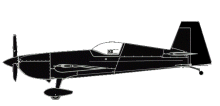
ASN Wikibase Occurrence # 228208
This information is added by users of ASN. Neither ASN nor the Flight Safety Foundation are responsible for the completeness or correctness of this information.
If you feel this information is incomplete or incorrect, you can submit corrected information.
| Date: | Wednesday 14 August 2019 |
| Time: | 06:25 LT |
| Type: |  Extra EA 300/L |
| Owner/operator: | Aviation Performance Solutions, LLC |
| Registration: | N19AM |
| MSN: | 046 |
| Year of manufacture: | 1997 |
| Total airframe hrs: | 3231 hours |
| Engine model: | Lycoming AEIO-540 |
| Fatalities: | Fatalities: 0 / Occupants: 2 |
| Aircraft damage: | Substantial |
| Category: | Accident |
| Location: | SE of Phoenix-Mesa Gateway Airport (KIWA), Phoenix, AZ -
 United States of America United States of America
|
| Phase: | Landing |
| Nature: | Training |
| Departure airport: | Phoenix-Mesa Gateway Airport, AZ [ (AZA/KIWA) |
| Phoenix-Mesa Gateway Airport, AZ [ (AZA/KIWA) | |
| Investigating agency: | NTSB |
| Confidence Rating: |
The flight instructor and student pilot were maneuvering the airplane as part of an upset prevention and recovery training curriculum. The flight instructor reported that the airplane lost partial engine power as he completed a rolling maneuver demonstration. The flight instructor immediately switched the fuel selector valve from the WING tank position to the ACRO/CENTER (acrobatic) fuel tank position; however, he was unable to restore full engine power and subsequently made an off-airport landing during which the airplane sustained substantial damage.
Postaccident onsite examination of the airplane revealed that the acro/center fuel tank contained approximately 13 gallons of avgas. The left-wing tank contained trace amounts of avgas and the right-wing tank contained approximately 6 gallons of avgas. Further examination of the airplane revealed that the electrically driven fuel boost pump, which the flight instructor reported was on during the accident flight, was inoperative. It would be used, in part, for emergencies and inflight restarts following an engine failure. The inoperative boost pump was removed and replaced with a segregate boost pump. The engine was then started and developed continuous power at varied throttle positions between idle to full power.
The flight manual states that aerobatic maneuvers must be accomplished with the fuel selector in the ACRO/CENTER (acrobatic) fuel tank position. The accident sequence is consistent with a partial loss of engine power likely due to an interruption of fuel flow while the flight instructor was performing aerobic maneuvers with the fuel sector in the WING tank position. It is likely that the fuel unported from the wing tanks, which resulted in fuel starvation and a partial loss of engine power. The inoperative electric fuel boost pump contributed to the flight instructor's inability to restart the engine.
Probable Cause: The flight instructor's operation of the airplane outside of the manufacturer's limitations, which resulted in fuel starvation and a partial loss of engine power. Contributing to the accident was an inoperative electric fuel boost pump.
Accident investigation:
 |
|
Sources:
NTSB WPR19LA218
FAA register: https://registry.faa.gov/aircraftinquiry/NNum_Results.aspx?NNumbertxt=19AM
History of this aircraft
Other occurrences involving this aircraft
| 20 February 1994 | D-EJXX | private | 2 | Küh |  |
w/o |
Location
Media:
The 2 ppl on this plane walked away w/out injuries east of @gatewayairport in Pinal County at arnd 730 this am. The Valley’s automatic aid system is the best in country. Sharing of fire resources makes for quick response times. Thx @GilbertFireDept & @TownofQC Fire/med @MesaPD pic.twitter.com/H4sNhpsQEf
— Mesa (Arizona) Fire & Medical Dept (@MesaFireDept) August 14, 2019
Revision history:
| Date/time | Contributor | Updates |
|---|---|---|
| 14-Aug-2019 16:13 | Geno | Added |
| 14-Aug-2019 18:03 | RobertMB | Updated [Source] |
| 14-Aug-2019 19:17 | Iceman 29 | Updated [Source, Embed code, Damage, Narrative] |
| 14-Aug-2019 19:42 | RobertMB | Updated [Operator, Embed code] |
| 20-Jul-2022 08:59 | ASN Update Bot | Updated [Time, Operator, Other fatalities, Departure airport, Destination airport, Source, Narrative, Category, Accident report] |
Corrections or additions? ... Edit this accident description
The Aviation Safety Network is an exclusive service provided by:


 ©2024 Flight Safety Foundation
©2024 Flight Safety Foundation